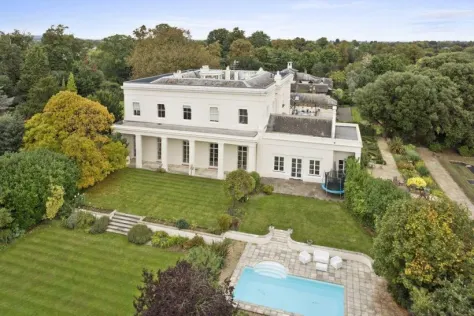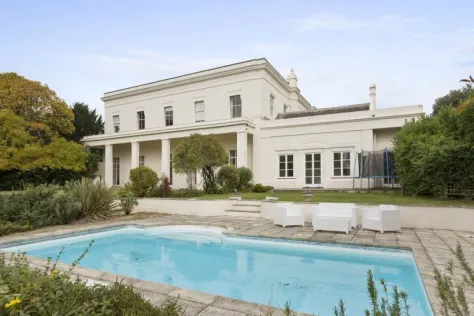Introduction
Laleham Abbey, formerly known as Laleham House, is a historic Grade II listed building situated in Laleham, Staines-upon-Thames, Surrey. Built between 1803 and 1806, the house was designed by renowned architect John Buonarotti Papworth in the Palladian style. Over the years, the house has undergone multiple modifications and has played a significant role in British aristocratic history. Today, it stands as a converted residential property.
Architectural Features
Original Construction
Laleham Abbey was originally constructed between 1803 and 1806. Designed by John Buonarotti Papworth, the house was built in a neo-Classical style, featuring a Doric portico, marble floors, and a cupola. The interior boasted a semi-circular staircase and grand columns, reflecting the grandeur of the era.
Modifications by Papworth
Papworth was later responsible for further modifications between 1827 and 1830. These alterations included the construction of new stables and a farm, which enhanced the functionality of the estate. The exterior of the house was adorned with stucco, with a symmetrical 2:1:2 bay structure. The ground floor featured moulded cill strings and sash windows, while the upper floors were distinguished by a Greek fret cornice and a blocking course.
Early Ownership and Residents
Richard Bingham, 2nd Earl of Lucan
Laleham House was originally built as a second home for Richard Bingham, the 2nd Earl of Lucan (1764-1839). However, following the breakdown of his marriage, he spent little time at the property. Instead, it was rented to Queen Maria II of Portugal, who lived there from 1829.
George Charles Bingham, 3rd Earl of Lucan
Upon the death of the 2nd Earl in 1839, the estate passed to his son, George Charles Bingham, the 3rd Earl of Lucan (1800-1888). A distinguished military officer, George commanded the cavalry in the Crimean War and was responsible for the infamous Charge of the Light Brigade at Balaclava in 1854. During his ownership, he commissioned further modifications to the house under the supervision of Papworth.
Later Years of the Lucan Family
Charles George Bingham, 4th Earl of Lucan
The house was inherited by Charles George Bingham, the 4th Earl of Lucan (1830-1914), in 1888. Throughout his life, Charles struggled with financial issues and faced near bankruptcy in 1899 and 1913. To alleviate financial burdens, he sold large portions of the estate, although he remained an active philanthropist within the Laleham community.
George Charles Bingham, 5th Earl of Lucan
In 1915, the house came under the ownership of George Charles Bingham, the 5th Earl of Lucan (1860-1949). Despite assuming control of the Lucan estates in 1900, he spent little time at Laleham House. During World War I, the house was rented to Grand Duke Michael of Russia and Countess Torby for a summer stay.
Transition to New Ownership
Sale to Lord Churston
By 1925, the Lucan Estates Company was seeking new revenue sources, leading to the sale of Laleham House to Lord Churston in 1928. John Reginald Lopes Yarde-Buller, 3rd Baron Churston (1873-1930), had recently suffered the devastating loss of his Lupton House in Devon due to a fire. Seeking a new residence, he moved into Laleham House, but his time there was short-lived as he passed away in 1930.
Art Sales and Financial Decline
His son, Richard-Yarde-Buller, 4th Baron Churston, later sold valuable works of art from the estate at Christie’s in 1932. Many of these treasures had originally been acquired by Lord Lucan.
Conversion into a Convent and Apartments
Use as a Convent School
After the death of Lord Churston, Laleham House underwent a significant transformation. It was acquired by the Sisters of St. Peter the Apostle, Westminster, and converted into a convent school. This marked a turning point in the property’s history, leading to its renaming as Laleham Abbey. The surrounding estate land was repurposed into a public park.
Residential Conversion in 1981
In 1981, Laleham Abbey was purchased by a property developer and converted into private apartments. This marked the final major transition in its history, allowing for the preservation of its architectural heritage while adapting it for modern residential use.
Notable Historical Context
The 7th Earl of Lucan’s Infamous Disappearance
The Lucan family name resurfaced in the public eye with the disappearance of Richard John Bingham, 7th Earl of Lucan, in 1974. He was accused of the murder of his children’s nanny, Sandra Rivett, and subsequently vanished. In 1975, he was declared guilty in absentia by a coroner’s jury. His legal death was officially declared in February 2016, further cementing the family’s association with mystery and intrigue.
Conclusion
Laleham Abbey, formerly known as Laleham House, has a rich and storied history spanning over two centuries. From its origins as a neo-Classical estate designed by John Buonarotti Papworth to its role as a residence for British nobility and later as a convent school, the house has witnessed significant transformations. Today, as a private residential property, it remains an important architectural and historical landmark in Surrey.
Location Information
Laleham Abbey Abbey Drive, Laleham, Staines-upon-Thames, Surrey, TW18 1SR






